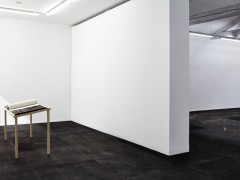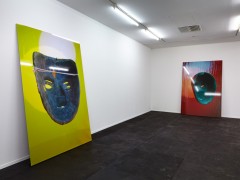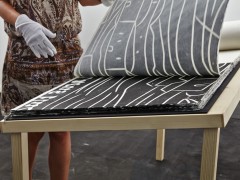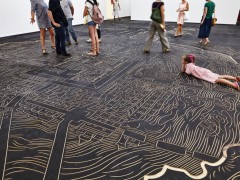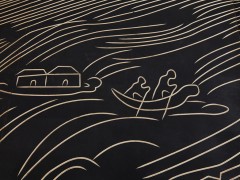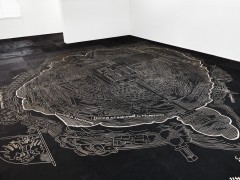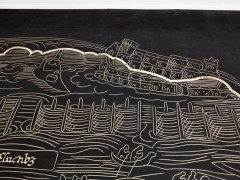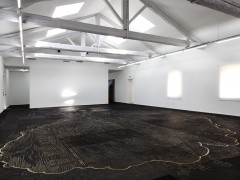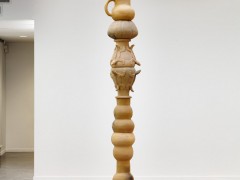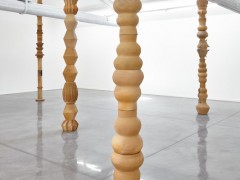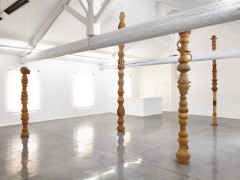Mariana Castillo Deball Cronotopo
18.06 – 30.08 / 2015
MRAC, Musée régional d’art contemporain Languedoc-Roussillon, Sérignan
Curators: Dorothée Dupuis and Oliver Martínez-Kandt
In her practice, Castillo Deball links conceptual traditions in art with archeology, history and ethnography to create installation, sculpture, photography, video and drawing that analyze the production of formal and linguistic vocabularies involved in object making, and how they have the ability to expose larger historical and social narratives. Her investigations seek to question and formulate the power struggles and negotiations inherent to all production processes, notably paying attention to specific post-colonial contexts where different cultures confront for access to representation and therefore, agency. Engaging in prolonged periods of research and field-work, she references both modern and contemporary archaeological and ethnographic methods in a playful way, narrating and deciphering the approximations, mistakes and contradictions that the idea of study- ing material cultures as fixed entities entails. Interested in the temporality of knowledge, Castillo Deball combines the exploration of archives and other information systems with the aesthetic vibrancy of cultural bricolage, appropriation and forgeries within encoded histories as well as the performative aspect of identity. Her research involves open col- laboration with different cultural producers, whether they be writers, crafts specialists, artists or institutional representatives through a voluntarily versatile network, aiming to expose the fluctuating political implications of their activities and visions. Challenging our assumptions of concepts such as authenticity and origin, she affirms the human capac- ity to crossbreed and cannibalize cleverly other cultures in order to survive as a universal and liberating characteristic of mankind.
For Cronotopo, the artist presents a combination of recent and newly commissioned art- works that reveal her working process as an evolving one. At the Mrac will be presented two majors works specifically produced for and adapted to the temporary exhibition spaces located on the first floor of the Museum. Nuremberg Map of Tenochtitlan (2013) is a monumental work covering the entire floor of one of the rooms. Made of simple wooden planks engraved and assembled so as to form a gigantic drawing, it reproduces a map, the first and the most widespread image that Europeans had of Tenochtitlán, and remains one of the few maps we have of the pre-colonial Aztec empire. In 1521, a letter and a map arrived in Spain for the Spanish king. This was the second of five letters that the conquistador Hernán Cortés sent describing the Aztec capital Tenochtitlán, which he and his crew had discovered and were near to conquering. The map, drawn by an Indigenous tlacuilo, was a detailed illustration of the city, reflecting the conquistador’s view of Tenochtitlán as an enchanted metropolis: a jewel rising up from the center of an azure lake, housing an ordered, wealthy civilization, who were nevertheless misled in their predilection for heathen ritual sacrifice instead of enlightened Christianity. This depiction of Tenochtitlán served to justify the expensive Spanish colonial efforts, but not only to Charles V, the king of Spain. The publication in Nuremberg of the map in 1524, along with the letter’s translation into Latin, also sparked the imagination and support of a large European audience.
The wooden surface is also used as a matrix from which a one-to-one print of the engraved surface is made onto paper. The work Atlas (2014) is then a bound compila- tion of these prints, giving to see the map and its various narratives from a fragmentary perspective.
The two photographs from the series Umriss (2014), show two colorful, uncanny large scale blow-ups of mexican masks seen from behind. These photos were inspired to Castillo Deball by a Mexican commercial for antidepressant from the 80s, that she restaged using masks from the ethnographic museum in Berlin: the artist thus underlines humorously, although quite dramatically, the sadness inherent to our post-colonial times.
Who will measure the space, who will tell me the time? (2015) is the second occurrence of a new body of work whose production started last January for a monographic show at the Museum of Contemporary Art of Oaxaca, Mexico. The artist worked in col- laboration, with local traditional ceramics workshop Taller Coatlicue (Familia Martinez Alarzón, Atzompa) and Innovando la tradición A.C, a series of ceramic elements drawing from existing archeological figures from the Prehispanic Art Museum Rufino Tamayo in Oaxaca, mixed with more contemporary patterns like gears, nuts or toys. These ele- ments are superposed in order to build columns, each functioning as a distinct sculp- tural narrative that attempts to develop two questions: “How do you tell the story of the universe in hundred years? How do you tell the story of the universe in one day?” The results, typical of Castillo Deball’s work, play off of the anachronistic confusion created by the forms that compose it, wherein the language of visual art updates and challenges the idea of tradition and identity that still presides over most craft productions, giving the possibility of expansion and mobility.
Castillo Deball sees contemporary art as an effective means of generating inclusive discussions about broader issues of representation and the actualization of the project of modernity, at a time when globalization seems almost fully achieved, and when local, tribal identities seem to fade ineluctably in front of the omnipresent figure of the Westernized global consumer. One of the main point of Castillo Deball’s work, is then to fight against the essentialization of identities, whether they be indigenous or anything else.
Mariana Castillo Deball (Mexico, 1975) lives and works between Mexico City and Berlin. Her recent exhibitions include: Museo de Arte Contemporáneo de Oaxaca; Hamburger Bahnhof-Museum für Gegenwart, as part of the Preis der Nationalgalerie für Junge Kunst 2014, Berlin; Kurimanzutto; Salomon R. Guggenheim, NY; 8th Berlin Biennial; CCA Glasgow Scotland / Chisenhale Gallery, London; TEOR / éTica, Costa Rica; Haus Konstruktiv, Zürich; dOCUMENTA 13, Kassel; 54th Venice Biennale; El Eco Experimental Museum; Wien Lukatsch, Berlin; Kölnischer Kunstverein; Kunst Halle Sankt Gallen; Manifesta 7, Italy; Museo de Arte Carrillo Gil, Mexico, among others. Mariana Castillo Deball
This post is also available in: Spanish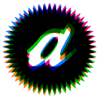

 Home
Home
